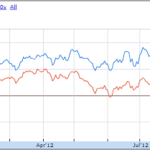Carry trades are a key part of international speculation. Investors borrow funds in low-cost markets like the US and Japan to invest internationally for a higher yield.
PIMCO thinks it can beat benchmarks to seek global yields with inflation protection. Its new fund, the Global Advantage Inflation-Linked Bond Strategy Fund (ILB) will invest in global inflation-protected securities. Inflation-protected securities are those which guarantee a minimum real rate of return. In the US, the government issues TIPS, or Treasury Inflation-Protected Securities, which pay a flat rate plus inflation as measured by the Consumer Price Index.
Inflation-protected securities are red hot with investors. Given that rates rest near multi-decade lows in many developed world countries, a positive real return is all investors really want for their investment capital allocated to fixed-income securities.
ILB’s Active Management
PIMCO will diverge from typical inflation-protected funds which are indexed to global and domestic bond benchmark indexes. PIMCO believes that with active management it can generate a real return greater than the index.
There is only one way for an active manager to beat the inflation-protected indexes: making correct calls on future inflation. That’s it.
The bond markets are incredibly efficient, so PIMCO will have to seek divergences between the yield on inflation-protected securities and implied inflation. It is understood that the difference in yields between the 10-year Treasury and a 10-year US TIPS is the expected inflation rate. If inflation comes in greater than expected, the TIPS provide a larger return than the 10-year non-adjusted Treasury. Alternatively, if inflation comes in lower than expected, TIPS provide a smaller return than ordinary Treasury securities.
Can active management add to returns?
This is the most difficult question to answer. PIMCO’s new fund will charge 60 basis points on fund assets each year, some 46 basis points more than Charles Schwab’s US TIPS ETF (SCHP).
The fund will invest only in inflation-protected bonds that have an economic link to at least 3 developed or emerging market nations, a requirement that keeps PIMCO out volatile issues from frontier countries. International issues should help buoy returns over purely-American funds.
Management is arguably the best in the active fixed-income fund space. Real return fund manager Mihir Worah will also lead the management of the new ILB ETF.
Fund Holdings
Knowing what’s in the fund can give us a more accurate estimation of future returns.
The six largest fund holdings are:
- US TIPS 10.92%
- Canadian Real Return Bonds 7.35%
- Japanese Inflation Protected Bonds 6.95%
- French IP Bonds 6.34%
- Mexican Bonds 6.07%
- Mexican Bonds 5.91%
Brazil also appears in the top 10 fund holdings. Emerging markets are mostly limited to a much smaller portion of total assets. The fund holds forward currency contracts to hedge much of the currency risk embedded in international bond investing. This substantially lowers the risk to investors that inflation is priced into the exchange rate for local currencies.
PIMCO lists an estimated yield to maturity of 3.78%. The effective duration for included securities is listed at 4.53 years, but, as the prospectus states, the fund effective duration may vary with active management by +/- 2 years.
If the estimated yield to maturity proves accurate, PIMCO should return 3.18% net of fees to investors. For comparison, ordinary US Treasury securities with a 5-year maturity will yield only .71%. Going overseas with inflation-linked bonds and removing exchange-rate risk with hedges proves to be a very profitable strategy – one that investors will have to watch carefully. Â Investors seeking international returns in this genre may also want to consider higher yielding International Bond ETFs.
Disclosure: the author holds no positions in any of the above ETFs.










{ 0 comments… add one now }